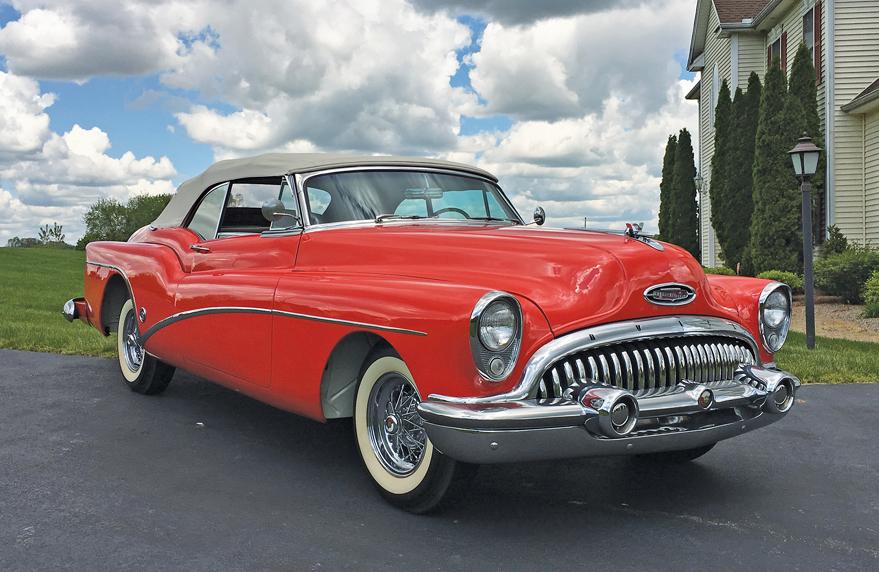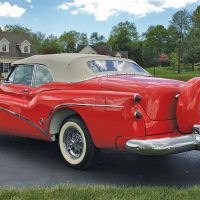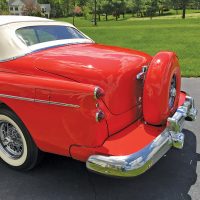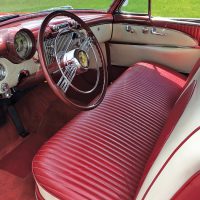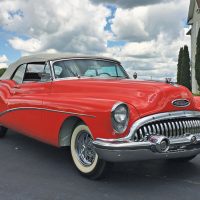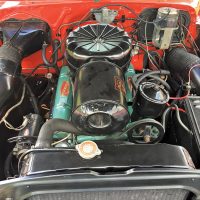SCM Analysis
Detailing
| Vehicle: | 1953 Buick Skylark Convertible |
| Years Produced: | 1953–54 |
| Number Produced: | 1,690 (in 1953) |
| Original List Price: | $5,000 |
| SCM Valuation: | $100,000 |
| Tune Up Cost: | $300 |
| Chassis Number Location: | On hinge pillar post and dash under hood |
| Engine Number Location: | On crankcase and cylinder block |
| Club Info: | ’53–’54 Buick Skylark Club |
| Website: | http://www.skylarkclub.org |
| Alternatives: | 1953 Oldsmobile Fiesta, 1954 Buick Skylark, 1953 Packard Caribbean |
| Investment Grade: | B |
This car, Lot 653, sold for $77,000, including buyer’s premium, at Barrett-Jackson’s Northeast sale held June 26–29 at the Mohegan Sun Casino in Uncasville, CT.
Harley Earl became the head of General Motors’ newly established “Art and Colour” department in 1927 — and he forever altered the design of American automobiles.
Design, once the purview of the engineers, was now based on melding the art world into automotive production. Earl’s redesign of the staid Pontiac doubled sales and saved the troubled marque — that is, until it met its ultimate demise several decades later.
Earl designed the first concept car developed by a major manufacturer, the Buick Y-Job, in 1938, and it received wide exposure as his personal transportation. Its futuristic design featured many advanced innovations that were integrated into later production models.
The 1950s were an era when automotive executives had unparalleled power and authority. They were unencumbered with committees and endless oversight.
So when Charles Chayne, Buick’s Chief Engineer and future GM Chief Engineer, had an inspiration for a concept car that would be as fresh as Harley Earl’s Y-Job, he developed the Buick XP-300.
Chayne was no stranger to exotic automobiles, as he once owned one of the massive Bugatti Type 41 Royales. The exciting XP-300 served as the basis for a sportier Buick, with the resulting prototype introduced at the 1952 Motorama in New York City.
Enter the Skylark
The Buick Skylark, part of a trio of Motorama dream cars, was introduced the following year — as concept cars that the public could actually acquire. The Oldsmobile Fiesta 98 and the Cadillac 62 Series Eldorado joined the Buick Skylark, and the public lusted over their futuristic features and designs.
The Skylark offered an overhead-valve V8 and a 12-volt system, firsts for Buick. It was lacking the traditional VentiPorts or portholes, maintaining clean, uninterrupted lines.
Skylarks had every conceivable accessory as standard equipment, including the new Selectronic radio with a foot-controlled knob for changing stations. Only 1,690 were produced, and at a price tag of $5,000, they were out of the reach of most buyers.
However, as intended, the exciting Skylark brought curious shoppers into Buick showrooms — where they could select a car that was more appropriate to their needs.
A spectacularly expensive car
The Skylark required a great deal of custom work, as the fenders, outer door panels and portions of the top required special stampings.
The inner door panels, from the Buick Roadmaster, were cut in half and welded back together to create the distinctive door dip.
The windshield, side windows and top were lowered three inches. A long, sweeping spear gave the illusion of length, and the cutout wheel openings created the appearance of a lower silhouette. The inner fenders were painted either white or red.
The result was spectacular.
The Skylark was an expensive car to manufacture and is an expensive car to restore today. The plating bill for the massive “buck-tooth” grille will make you question the entire project, and replacing the narrow-pleated leather seating is a costly project.
The handwork required a great deal of lead — especially behind the doors — and finding qualified craftsmen today is difficult. It is not unheard of to spend $200,000 or more in a quality restoration.
A great car in a falling market
The Buick Skylark, unfortunately, has followed the general malaise of most of the 1950s American cars.
RM Auctions, at their 2007 sale of the McMullen Collection, sold an exceptional example for $495,000. A well-restored Skylark sold at $383,400 at Barrett-Jackson’s March 2006 Palm Beach sale.
Since then it has been all downhill.
The vast majority of the Skylarks produced avoided the crusher, so there are plenty to choose from.
In fact, the SCM Platinum Auction Database lists more than two dozen transactions since January 2018. It is not difficult to find comparable sales, but it is difficult to interpret the information.
Early in 2018, several Skylarks sold for six figures, but of late they have struggled to come close. Every now and then they show signs of life — but quickly return to the doldrums. They are wonderful cars, so why are they languishing?
Betwixt and between
One thought is that Skylarks are in the cusp between being a car that was lusted after in one’s youth and an iconic collectible. It is a transition that many Brass Era cars and Full Classics have experienced.
The Skylark offered by Barrett-Jackson appeared to have been well restored and properly cared for. It was an absolute bargain, but will it see future appreciation?
Not anytime soon.
I have often stated that the Skylark’s resurgence is about to happen, but based on recent sales, I feel that the high five figures is the new norm and will be so for the foreseeable future. ♦
(Introductory description courtesy of Barrett-Jackson.)
